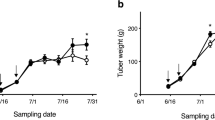Abstract
Foliar applications of the synthetic auxin compound 2,4-dichlorophenoxyacetic acid (2,4-D) have been used to enhance skin color of red potato cultivars for many years. Relatively, little is known about the mode of action of this compound, but it has been proposed that 2,4-D stimulates ethylene production and enhances the activity of enzymes involved in anthocyanin biosynthesis. The objective of this study was to compare several other plant growth regulators to 2,4-D for their effect on plant growth, tuber yield, and skin color of the light red-skinned cultivar “Red Lasoda.” Trials were conducted in 2010 and 2011 to evaluate the effects of foliar applications of the ethylene-stimulating growth regulator ethephon, the ethylene-inhibitor 1-methylcyclopropene (1-MCP), and 2,4-D. Manual inflorescence removal was also included as a treatment to determine the influence of anthocyanin sink competition between tubers and flowers on tuber skin color. Ethephon application caused floral abscission in treated plants and reduced plant height compared to other treatments and the non-treated control. While 2,4-D caused foliar injury and ethephon slightly increased the yield of <56 g tubers, neither growth regulator affected total and marketable yield. Both ethephon and 2,4-D increased tuber skin color at harvest compared to the non-treated control. In contrast, 1-MCP and inflorescence removal had no effect on yield, tuber size, and skin color. The results indicate that ethephon and 2,4-D foliar applications have similar effects on skin color and appearance, supporting the hypothesis that 2,4-D works by stimulating ethylene production within the plant.

Similar content being viewed by others
References
Bartholdi WL (1942) Influence of flowering and fruiting upon vegetative growth and tuber yield in the potato. Minnesota Agricultural Experiment Station Bulletin number 150
Batal KM, Granberry DM (1982) Effects of growth regulators on ripening and abscission of pimento and pepper fruit. HortSci 17:944–946
Blanpied GD, Forshey CG, Styles WC, Green DW, Lord WJ, Bramlage WJ (1975) Use of ethephon to stimulate red color without hastening ripening of ‘McIntosh’ apples. J Am Soc Horticult Sci 100:379–381
Cantliffe DJ, Goodwin P (1975) Red color enhancement of pepper fruits by multiple applications of ethephon. J Am Horticult Sci 100:157–161
Fritz VA, Hebel JB, Borowski AM, Hung PE (1991) Ethephon and 2,4-D do not improve periderm color and may decrease yield in red-skinned ‘Norland’ Potato. HortSci 26(5):553–555
Fults JL, Schaal LA (1950) Red skin color of Bliss Triumph potatoes increased by the use of synthetic plant hormones. Science 108:411
Fults JL, Schaal LA, Landblom N, Payne MG (1950) Stabilization and intensification of red skin color in Red McClure potatoes by the use of the sodium salt of 2,4-dichlorophenoxyacetic acid. Am J Potato Res 27:377–395
Goeschl JD, Rappaport L, Pratt HK (1966) Ethylene as a factor regulating the growth of pea epicotyls subjected to physical stress. Plant Physiol 41:877–884
Holm RE, Abeles FB (1968) The role of ethylene in 2,4-D-induced growth inhibition. Planta (Berlin) 78:293–304
Institute SAS (2008) SAS user’s guide; Version 9.2. SAS Institute, Inc, Cary, NC
Jansky SH, Thompson DM (1990) The effect of flower removal on potato tuber yield. Can J Plant Sci 70:1223–1225
Jiang YM, Joyce DC, Terry LA (2001) 1-Methylcyclopropene treatment affects strawberry fruit decay. Postharvest Biol Tech 23:227–232
Kyu KS, Taek KJ, Seog HJ, Kim NY (1998) Effect of ethephon and ABA application on coloration, content, and composition of anthocyanin in grapes (Vitis sp.). J Kor Soc Hort Sci 39:547–554
Locascio SJ (1977) Color enhancement of bell pepper with ethephon. Proc Fla State Hort Soc 90:421–423
Lockwood D, Vines HM (1972) Red color enhancement of pimiento peppers with (2-chloroethyl) phosphonic acid. J Am Soc Horticult Sci 97(2):192–197
Love SL, Novy R, Corsini DL, Bain P (2003) Variety selection and management. Potato Production Systems. University of Idaho Agricultural Communications pp.45
Nylund RE (1956) The use of 2,4-D to intensify the skin color of Pontiac potatoes. Am J Potato Res 33(5):145–154
Payne MG, Fults JL, Hay R, Landblom N, Schaal LA (1951) The effect of storage on color and sprouting of Red McClure potatoes after 2,4-D treatment. Am J Potato Res 28(1):455–464
Prange R, Pruski K, Daniels-Lake B (2005) Effects of continuous ethylene treatment on potato tubers: highlights of 14 years of research. Acta Horticult 684:165–170
Prince FS, Blood PT (1949) The effects of 2,4-D on potato tops and tubers when sprayed at full-bloom stage. Agron J 41:219–220
Rosen CJ, Roessler JA, Petracek PD, Engelman S, Tong CBS (2009) 2,4-dichlorophenoxyacetic acid increases peonidin derivatives in Red Norland periderm. Am J Potato Res 86:15–23
Russo L, Dostal HC, Leopold AC (1968) Chemical regulation of fruit ripening. Bioscience 18:109
Schrader WL (1987) Use of ethephon for control of potato tuber size. Acta Horticult 201:171–174
Sisler EC, Serek M (2003) Compounds interacting with the ethylene receptor in plants. Plant Biol 5:473–480
Thornton MK, Lee J, John R, Olsen N, Navarre DA (2013) Influence of growth regulators on plant growth, yield, and skin color of specialty potatoes. Am J Potato Res 90(3):271–283
van Doorn WG (2002) Effects of ethylene on flower abscission: a survey. Ann Bot 89:689–693
Waterer D (2010) Influence of growth regulators on skin colour and scab diseases of red-skinned potatoes. Can J Plant Sci 90:745–753
Acknowledgments
Funding for this research project was provided, in part, by the Idaho Agricultural Experiment Station, USDA-NIFA, and the Idaho Potato Commission. We also thank Ms. Oksana Adams for her help in conducting the field and harvest evaluations.
Author information
Authors and Affiliations
Corresponding author
Rights and permissions
About this article
Cite this article
Thornton, M.K., John, R. & Buhrig, W. The Influence of Plant Growth Regulators and Inflorescence Removal on Plant Growth, Yield, and Skin Color of Red LaSoda Tubers. Potato Res. 57, 123–131 (2014). https://doi.org/10.1007/s11540-014-9257-1
Received:
Accepted:
Published:
Issue Date:
DOI: https://doi.org/10.1007/s11540-014-9257-1




